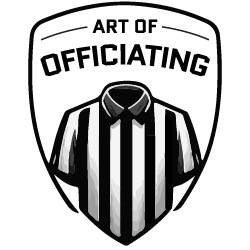One of the most important aspects of officiating is how we communicate with coaches. Too often, officials fall into the trap of trying to convince a coach that they are right. That’s not our job.
Our job is to communicate facts, clarify what we saw, and answer the coach’s questions. The end goal is not to win an argument but to provide the information the coach needs.
- “Coach, by rule…” → when the decision is rooted in a clear rules reference.
- “Coach, in my judgment…” → when the call is based on officiating discretion.
- “Coach, I spoke with the line judge (opposite wing). He said number 45…” → to answer a coach’s question about a previous event.
These phrases keep the discussion professional, factual, and focused.
Avoid the Debate Trap
When we shift into convincing mode, we’re trying to persuade the coach to accept our view. That easily slides into arguing, and once you’re in an argument, you’ve already lost. You don’t need to win the coach over. You need to provide facts.
Remember: sometimes the coach will not agree, and sometimes the coach will not be happy. That’s okay. Their role is to advocate for their team. Ours is to apply the rules fairly.
The End State: Professional Communication
The “win” is not the coach nodding in agreement or walking away satisfied. The win is this: you provided accurate, concise, and professional communication, and then allowed the coach to draw his own conclusion.
If the coach walks away and is still angry or doesn’t agree with you, that’s okay. Let the coach walk away. Don’t chase the coach and continue the conversation to try to convince him you are right.
Don’t initiate a conversation with a coach unless you need to provide valuable information, either answering a coach’s question about a previous event, or “putting money in the bank” by informing the coach of something that he can fix to avoid a foul.
Stay calm. Stick to the facts. Avoid debate. That’s the mark of a professional communicator on the field.
Quiz
Read the quiz stem and then choose the best answer.
4/5 from the K-30. K33 holds R17 at the line of scrimmage. R45 catches the punt and returns the ball for a touchdown.
- Team R must decline the penalty for K33’s foul to keep the touchdown
- Team R can enforce the penalty for K33’s foul on the try or the succeeding kickoff
- Team R must enforce the penalty for K33’s foul on the try
Review Rules 8-2 and 10-4-2 EXCEPTION
